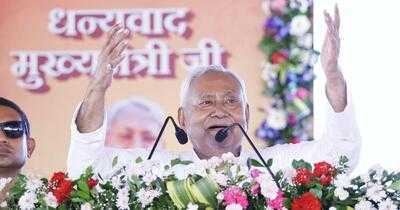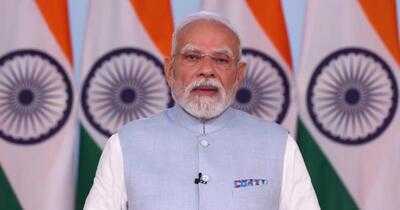
India’s equity markets have had a volatile year so far, amid a weak global economic environment, geopolitical tensions, and lacklustre earnings.
The steep 50 per cent tariffs imposed by the US on Indian imports have also weighed on investor sentiments and have cast a shadow on India’s growth.
Since the beginning of 2025, the BSE Sensex is up just 6 per cent. In what has arguably been a strong year for emerging markets, which have seen over 30 per cent in gains in US dollar terms, India’s equity markets have just delivered 3 per cent returns.
Amid these weaknesses, foreign portfolio investors have sold over Rs 1.52 lakh crore from India’s equity market so far in 2025.
However, a few international brokerages have begun turning positive on India.
Goldman Sachs, for instance, has turned overweight on India and sees the NSE Nifty50 index at 29,000 by the end of 2026, which is around 14 per cent upside from the current levels.
HSBC too has recently upgraded Indian equities and is expecting the Sensex to touch 94,000 by the end of 2026, 13 per cent higher than the current level.
The common opinion of the two is that after a year of underperformance, perhaps better days may be ahead for Indian equities. Valuations are also perhaps more supportive now, following the underperformance.
“Easing measures from RBI announced this year, GST cuts, and slower fiscal consolidation ahead should aid growth recovery over the next two years. The year-long EPS (earnings per share) downgrade cycle has lasted longer than the typical median cycle and stabilised over the past three months. Third quarter (July-September) calendar 2025 results are tracking better versus low expectations leading to upgrades in select pockets,” said Goldman’s Emerging Market Equity Strategist Sunil Koul.
The expectation is that MSCI India (the index measuring large and mid-cap segments in India’s equity market) profits will recover to 14 per cent next year from 10 per cent this year.
With foreigners net selling $30 billion from India’s equity market over the past year, which is the second largest historically, foreign ownership allocations are near two-decade lows, Koul pointed.
Furthermore, India’s relative valuation premium to Asia has normalised to 45 per cent currently from 85-90 per cent at peak, historically leading to moderate outperformance, according to Goldman.
After underperforming in Asia by 30 per cent in the past 12 months, the worst may be over for Indian equities, feels Herald van der Linde, head of equity strategy, Asia Pacific, at HSBC. He pointed that India is now the biggest underweight in GEM (global emerging market) portfolios and only a quarter of funds they track are overweight in India.
“India offers a hedge and diversification to those who feel uncomfortable with the ongoing AI rally. India is likely to be an outsized beneficiary of any additional money coming into emerging markets region,” Linde opined.
Linde also felt that earnings had bottomed out in India, and expects a broad-based recovery in 2026.
What are the growth opportunities that these brokerages see in India?
“We remain positive on the consumer sectors like staples and autos, and upgrade durables to overweight as we expect ongoing mass consumption recovery to gather steam over the next two years amid low food inflation, strong agricultural cycle, lagged effects of GST rate cuts, upcoming elections in key states through 2026-27, and potential wage hikes from the 8th Pay Commission,” said Koul.
Goldman is expecting a recovery in volumes for consumer staples firms from the next quarter. Further gains are also expected in automobile companies over the next year, as volumes recover and earnings accelerate given the low base, underpenetration and tailwinds from easier financial conditions, and consumption recovery.
Banks have been a “massive drag” on growth this year, pointed HSBC’s Linde, but as deposits are rolled over at lower interest rates, margins are expected to expand in coming quarters. Linde also sees demand likely increasing for technology companies.
“Consumer names, including autos, are poised to benefit from GST reductions, lower inflation, and lower interest rates. However, the sustainability of demand influenced by tax cuts remains to be seen,” he noted.
Goldman is expecting banking profits to grow 15 per cent in 2026 from 8 per cent this year, aided by loan growth recovery.
In October, the broader large cap, mid-cap, and small-cap indices gained. However, a “sombre start” to November suggests equity is still stuck in “rangebound consolidation” that’s been ongoing for over a year, noted Rajeev Radhakrishnan and Gaurav Mehta of SBI Funds Management, the country’s largest asset manager.
They believe that with the disruption of GST behind, the impact of the lower rates should be visible on demand going ahead. There are also suggestions that India and US may be making good progress on a trade deal, although nothing concrete has materialised yet.
“In this context, earnings may be troughing and the outlook should improve going ahead. Consensus expectations indeed reflect that with an improvement in breadth of earnings revisions. We believe a meaningful acceleration in earnings trajectory will be crucial for markets to post a sustained recovery,” the two said.
-
Bihar result: Nitish Kumar's JD(U) leading on 85 seats, almost double its 2020 tally

-
Bihar result: BJP emerges as single-largest party, leading in 89 seats of 101 it contested

-
I'm A Celeb legend given cancer diagnosis after show medical exams

-
Zelio E-Mobility H1 Profit Jumps 69% YoY To INR 11.8 Cr

-
Tennis LIVE: Emma Raducanu left surprised as Jannik Sinner has 'a lot to lose'
